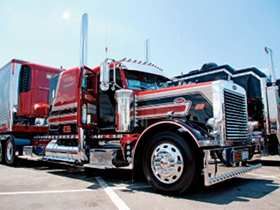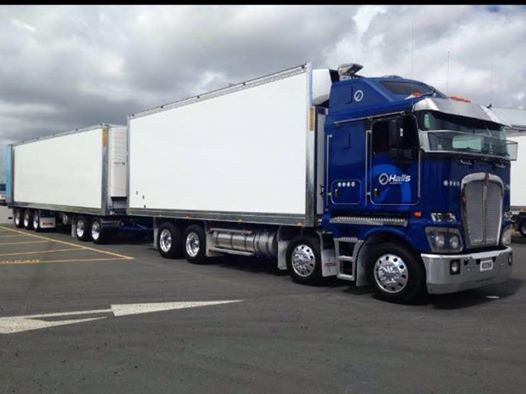Hours Of Operation
Topic 210 | Page 1
Somewhat normal? Heck, if you didn't have much trouble learning those rules and didn't find them massively confusing in the beginning you'd be the only one I ever heard of! 
They're confusing at best, and some of them - especially the split sleeper berth rule - are just confounding at first.
It's all about repetition. You just have to keep going over them time and time again and once you have em you'll wonder what you used to find so difficult about em.
But everyone struggles with the logbook rules. You'll get em soon enough.
Logbook:
A written or electronic record of a driver's duty status which must be maintained at all times. The driver records the amount of time spent driving, on-duty not driving, in the sleeper berth, or off duty. The enforcement of the Hours Of Service Rules (HOS) are based upon the entries put in a driver's logbook.
Sleeper Berth:
The portion of the tractor behind the seats which acts as the "living space" for the driver. It generally contains a bed (or bunk beds), cabinets, lights, temperature control knobs, and 12 volt plugs for power.
HOS:
Hours Of Service
HOS refers to the logbook hours of service regulations.



 Thanks Brett I was starting to think I was too dense to pull this off!
Thanks Brett I was starting to think I was too dense to pull this off!




 Lord, the log books have just about done this ole gal in! Like you I THOUGHT I had a good head on my shoulders, but heckfire, I feel like I might as well be reading German! ESPECIALLY THE SPLIT SLEEPER BERTH! Good Grief, it's bad! We will just have to keep plugging along I guess. GOOD LUCK TO YOU!!!!
Lord, the log books have just about done this ole gal in! Like you I THOUGHT I had a good head on my shoulders, but heckfire, I feel like I might as well be reading German! ESPECIALLY THE SPLIT SLEEPER BERTH! Good Grief, it's bad! We will just have to keep plugging along I guess. GOOD LUCK TO YOU!!!!
Sleeper Berth:
The portion of the tractor behind the seats which acts as the "living space" for the driver. It generally contains a bed (or bunk beds), cabinets, lights, temperature control knobs, and 12 volt plugs for power.

Lord, the log books have just about done this ole gal in! Like you I THOUGHT I had a good head on my shoulders, but heckfire, I feel like I might as well be reading German! ESPECIALLY THE SPLIT SLEEPER BERTH! Good Grief, it's bad! We will just have to keep plugging along I guess. GOOD LUCK TO YOU!!!!
Thanks Kathy! It's nice knowing yur not alone with a problem.
Sleeper Berth:
The portion of the tractor behind the seats which acts as the "living space" for the driver. It generally contains a bed (or bunk beds), cabinets, lights, temperature control knobs, and 12 volt plugs for power.
OWI:
Operating While Intoxicated

What are the actual rules of hours of operation now in place. I keep on seeing differences all over the place or doesn't anyone really know any more.

What are the actual rules of hours of operation now in place. I keep on seeing differences all over the place or doesn't anyone really know any more.
11,14,70.........you can only drive 11 hours and you have 14 hours to do it in with a maximum of 70 hours in 8 days.

Makes me glad I'm starting here in NZ. It's simple.
A Cumulative work period is 70 hours. at the end of the cumulative work period there must be an uninterrupted rest period of 24 hours.
A cumulative work day is 13 hours permitted work time in a 24 hour period, at the end of the cumulative work day there must be an ununterrupted rest period of 10 hours.
A driver may work a maximum period of 5.5 hours before a mandatory 30 minute break.
There are only 2 columns in the logbook. On Duty and Off Duty. If you're not on duty and working, you're off duty.
No 14 hours work period of which 11 can be driving, Just 13 hours work for the 24 hour period. Your 24 hour period can start whenever you wish, and ends 24 hours later. so if you drive somewhere for 2 hours and have to wait 5 hours to be unloaded and loaded, you haven't lost a big chunk of work time, you were just off duty and can carry on working another 11 hours after the yard hands finish loading.
No recaps, you just work to 70 accumulated hours and have 24 hours off, then start the cumulative 70 hour Talley again.
No split sleeper berths, just make sure you have 10 hours between stopping for the work day and starting the next day.
Logbook:
A written or electronic record of a driver's duty status which must be maintained at all times. The driver records the amount of time spent driving, on-duty not driving, in the sleeper berth, or off duty. The enforcement of the Hours Of Service Rules (HOS) are based upon the entries put in a driver's logbook.
Sleeper Berth:
The portion of the tractor behind the seats which acts as the "living space" for the driver. It generally contains a bed (or bunk beds), cabinets, lights, temperature control knobs, and 12 volt plugs for power.

Makes me glad I drive a day cab and the sleeper rule has no bearing on what I do. 11,14, and 70 are all I have to concern myself with. At this point anyway.
Day Cab:
A tractor which does not have a sleeper berth attached to it. Normally used for local routes where drivers go home every night.

Makes me glad I'm starting here in NZ. It's simple.
A Cumulative work period is 70 hours. at the end of the cumulative work period there must be an uninterrupted rest period of 24 hours.
A cumulative work day is 13 hours permitted work time in a 24 hour period, at the end of the cumulative work day there must be an ununterrupted rest period of 10 hours.
A driver may work a maximum period of 5.5 hours before a mandatory 30 minute break.
There are only 2 columns in the logbook. On Duty and Off Duty. If you're not on duty and working, you're off duty.
No 14 hours work period of which 11 can be driving, Just 13 hours work for the 24 hour period. Your 24 hour period can start whenever you wish, and ends 24 hours later. so if you drive somewhere for 2 hours and have to wait 5 hours to be unloaded and loaded, you haven't lost a big chunk of work time, you were just off duty and can carry on working another 11 hours after the yard hands finish loading.
No recaps, you just work to 70 accumulated hours and have 24 hours off, then start the cumulative 70 hour Talley again.
No split sleeper berths, just make sure you have 10 hours between stopping for the work day and starting the next day.
Kiwi303 where are you getting this info? This is a mixed bag of rule listing here and are not true in the US. Must be the HOS for Canada but that can't be right either as they are allowed a 16 hour work day.
I am so confused on this. I see it was you are from NJ so I assume these are HOS for New Zealand? .....what country are those HOS for?
The guy that asked was from Florida.
Logbook:
A written or electronic record of a driver's duty status which must be maintained at all times. The driver records the amount of time spent driving, on-duty not driving, in the sleeper berth, or off duty. The enforcement of the Hours Of Service Rules (HOS) are based upon the entries put in a driver's logbook.
Sleeper Berth:
The portion of the tractor behind the seats which acts as the "living space" for the driver. It generally contains a bed (or bunk beds), cabinets, lights, temperature control knobs, and 12 volt plugs for power.
HOS:
Hours Of Service
HOS refers to the logbook hours of service regulations.New Reply:
New! Check out our help videos for a better understanding of our forum features

















Preview:
This topic has the following tags:
Advice For New Truck Drivers High Road Training Program Hours Of Service Logbook Questions







 TT On Facebook
TT On Facebook
I have been going through the online CDL training program here and would like to say thank you for providing this valuable tool!
Well I had been sailing along quite well until I hit the section on hours of operation and logs when I started having some trouble.
Is it just me or is it somewhat normal to be confused by this information?
I get the basics but it seems every time I think I have the rules nailed some other provision gets me.
I thought I was of reasonable smarts but this is frustrating me a bit!
CDL:
Commercial Driver's License (CDL)
A CDL is required to drive any of the following vehicles: